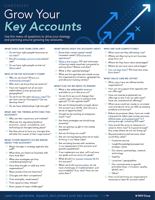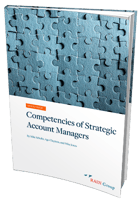Your team just won a new logo! Congratulations!
This one has buzz. It’s modest to start, but there’s potential to sell into multiple buying centers, across geographies, and the new product your company is launching will help the customer simplify their processes, increase efficiencies, and reduce strain on their supply chain.
But that’s all in the hands of the key account team now.
What is key account management (KAM)?
Key account management is a systematic approach to managing and growing a named set of an account manager’s most important customers to maximize mutual value and achieve mutually beneficial goals.
The good news is that new business from key accounts is 60% to 70% more likely to close compared to the 5% to 20% likelihood of closing a deal with a new client.
Assuming the initial engagement goes well, your account team will be well positioned to start pursuing additional growth opportunities.
Benefits of Key Account Management
If you have growth goals this year, account management and retention should be a priority: research shows that a 5% increase in customer retention increases profits by as much as 95%.
Moreover, as we found in our key account management (KAM) research, the organizations that are best at account management see drastically better account growth:
- 3.1X more likely to grow revenue by 20% or more in their key accounts
- 3.4X more likely to grow profit by 20% or more
- 4.5X more likely to experience year-over-year client satisfaction improvement
Top Performers in Key Account Management Compared to The Rest
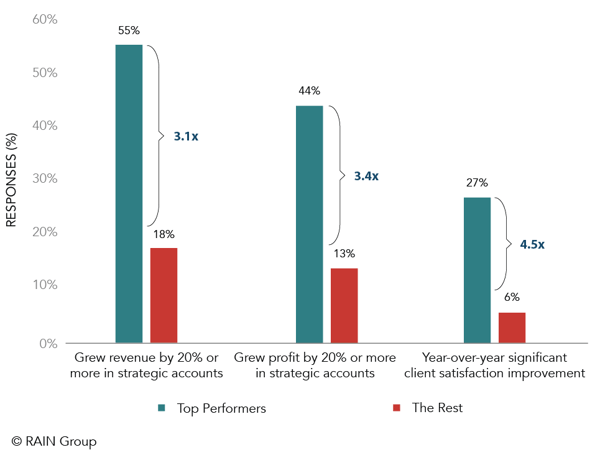 Source: Top Performance in Strategic Account Management Benchmark Report, RAIN Group Center for Sales Research
Source: Top Performance in Strategic Account Management Benchmark Report, RAIN Group Center for Sales Research
9 Key Account Management Best Practices
Despite its benefits, most companies—87%—aren’t among the best when it comes to account management. Among other reasons, many don’t have an established key account management strategy in place or lack organizational support.
Based on our research and experience with clients, we find the organizations and teams that succeed typically have 9 things in common. They:
1. Have an effective definition of key account management
When companies lack an effective and universally understood definition of key account management, their success is hampered from the start. If you can’t define something, it’s difficult to do it.
Beyond a core definition, we find that having a shared understanding of the following six components of key account management helps as well.
6 Components of Defining Key Account Management
- Viewing key accounts as separate from those that are simply large in terms of revenue
- Limiting the number of key accounts and protecting vigorously from uncontrolled list growth
- Pursuing key accounts as institutional partners with whom you collaborate and co-create value
- Allocating key account focus on three core topics: penetrating, expanding, and protecting accounts from competition
- Viewing key accounts as assets that require continued, and often significant, investment to yield maximum returns (including structure and process changes to maximize account value)
- Viewing key account investment returns as tied to long-term business strategy
Companies that agree on a definition and its key components create a solid foundation for their KAM program.
2. Learn to identify key accounts
Not every customer is a good fit for key account management. When you can identify key accounts, you can spend your time and effort on those most likely to get results. Let's start with a definition.
What is a key account?
There are two types of key accounts: 1) those that are already large, where business must be sustained and protected, and 2) those that aren't yet large, but have great growth potential.
We call these existing key accounts and emerging key accounts.
Key accounts aren’t necessarily your biggest revenue-generating clients. You may classify a key account because they have the potential to be a marquee client, or they’re an attractive logo on your client roster. There could be excellent growth in their industry, or they may be a prime target for being acquired. There are any number of factors unique to your organization that could lead you to classify a key account.
At a minimum, account managers should consider factors such as the:
- Current revenue
- Potential for growth
- Likelihood for renewals
- Likelihood you can succeed to win now and grow them later
- Relative effort it would take to make headway with them
- Relationship strength
- Fit of offers, cultural fit, or focus on their industry
- Attractiveness of logo
With limited time and resources, you often have to make difficult decisions about which accounts get your focus. Top Performers know this—and know their time is precious—so they value it and apply it accordingly.
Once you’ve identified a key account, it’s time to make a plan to grow the account.
3. Master account-growth planning and execution
Strong account plans and planning correlate significantly to top performance, according to our Top Performance in Strategic Account Management research. In fact, more than two-thirds of Top Performers report that account managers lead the account-planning process effectively and ensure the execution of account plans compared to one-third of The Rest.
Creating a key account growth plan can be overwhelming. It’s hard to know where to start. We’ve compiled a list of 57 questions to put you on the right path.
The questions are separated into 8 categories:
- What does our team look like?
- Who’s on the account’s team?
- What are the trends affecting this account?
- What needs do they have?
- What other insights do we know about this account?
- Who are our competitors?
- What value can we offer?
- What else do we need to know?
Keep in mind that your goal isn’t to answer all 57 questions. The relevancy of the questions will vary by account. Also, as you answer questions, you may realize the account isn’t a good candidate for your key account management program at all. That’s okay. It’s better to recognize this early on so you don’t waste time.
Once you’ve answered these questions, organize them in a key account tool, define the actions you need to take, and identify the resources needed. Ask yourself the following:
- What questions do you still need to answer?
- Which pieces of information are you missing?
- Who’s assigned to these tasks?
- What’s the deadline?
Stick to your KAM process (see the next point) and you’ll be well on your way to top performance.
4. Build a key account management process
Many companies that have selling built into their culture and systems believe they have all they need to implement key account management.
But as we note in #6 below, KAM and selling aren't the same thing. Key account management processes should be systematic, action-oriented, and designed to produce specific outputs.
Our research found that 45% of Top Performers report having a world-class, or at least a defined, account management process compared to 25% of The Rest. Also, Top Performers have much stronger processes in place to build account plans, find untapped value, hold teams accountable, and train in account management skills.
We find that a 5-stage process works best for account management. Ours looks like this:
5 Stage Key Account Management Process

It’s flexible and can be calibrated up or down depending on your needs. If it’s mission critical to grow an account, you can drill down into each of these categories, but if you have an account that needs less rigor, you can use the same process and work through it faster.
- Strategy: Know what you’re planning to do, with whom, and why
- Research: Begin work on the account plan, form the core account team, and gather data to inform your strategy
- Action Plan: With gathered information, develop a compelling case that will guide you to implementation
- Execution: This is where opportunities are created, expanded, and captured; relationships are deepened; and competitors neutralized
- Review: Analyze KPIs and adjust your action plan
What the Top Performers do well is embedded into the 5-stage account-management process. If you want your account management efforts to yield results, follow a process that covers these areas.
5. Put the right people in the right roles
What is a key account manager?
Once an account is identified as a key account, a key account manager nurtures the client relationship. Their primary goal is to look for ways to add value to the account in meaningful ways and expand the work your company does with the client. They’re often involved with customer satisfaction, customer service, and retention.
Sounds like a lot, right? That’s because it is. In fact, there are 6 account management roles that need to be represented on your account teams, but very rarely does the key account manager, or one person, do them all well.
6 Account Management Roles
![]()
Some people are good at building and enhancing relationships, but aren’t great at finding innovative ways to deliver value. Others are great at finding ways to deliver value, but aren’t good at organizing teams to share ideas internally or with clients. People who are great at organizing the team and getting things done may not be good at either building client relationships or innovating, and so on.
The key account manager will often play several roles, as do other members of the team. Most companies have the roles of Technical Expert, Relationship Lead, and Collaborator covered on their account teams. The others are less common. But if you want to drive the most account growth, make sure the roles of Project Manager, Innovator, and Results Driver are covered, too.
6. Know the difference between selling and account management
When we ask our clients what they need to do to maximize success with key accounts, we often hear:
- The leaders at our accounts need to know about the value we can bring them besides what we’re doing for them right now
- We need to penetrate new and different divisions of the accounts
- Our relationships need to be deeper if we want to keep our competitors out
- We need to work directly with decision-makers at the enterprise level
All good points, but not unique to key account management. In fact, we often get these same responses when we ask them what they’d like their sellers to do more of.
While many of the outcomes of KAM and sales are the same (e.g., higher revenue, higher margins, longer contracts, deeper penetration, more mindshare, more products and services sold, stronger relationships), the paths to get there are quite different.
If you can sell effectively and bring new ideas to your buyers early, you’ve set yourself up to become a valuable resource for them in the future. However, while sales is often a short-term effort to capture opportunities and move through the sales cycle, key account management requires long-term planning and strategy. Once you have your foot in the door by way of a successful sale, you can work with your organization to build trust, ensure client satisfaction, and create a bespoke strategy for your key accounts.
Read Now: 5 Ways Account Management and Selling Are Different >>
7. Have a thorough knowledge of your offerings and value
When clients don’t buy from you again and it’s not related to satisfaction, it’s often related to lack of knowledge. The client may not know:
- A product or service that could help them exists at all
- They have a problem your other product or service solves
- The value of solving the problem with your product, service, or capability, or they don’t see the impact as a priority
It’s up to account managers to solve these issues, but they often don’t:
- Ask themselves and their teams what additional value they could be delivering
- Have enough familiarity with all areas of their own business and don’t ask or involve the people who do
- Know the questions to ask that would uncover problems they could be solving for the client
- Engage in conversations when they do discover something because they don’t know enough or are uncomfortable with those types of discussions
It’s important to equip account teams across all roles with expert knowledge of all the value you can deliver to clients. This doesn’t mean everyone must be an expert in everything. But, at a minimum, team members must be able to speak fluently about:
- The range of customer needs you solve
- Your products, services, and overall capabilities as solutions to those needs
- The marketplace
- Your company and your value proposition
- The competition and how you’re a better value
Account managers must be fluent in these areas to have productive conversations with existing clients. The same skills that allow a seller to excel across the selling process are applicable when growing accounts.
8. Establish internal trust and collaboration
Account management requires trust, cooperation, and collaboration between you and your clients. When you lack these within your own organization, you can’t bring them alive for clients.
This isn’t a skill issue. It’s not a value delivery or capability issue. It’s not even a belief issue, as people generally believe they should trust each other and collaborate.
It’s the elephant in the room that people don’t want to talk about. Yet, it can have a significant negative impact on your account growth initiatives. It may look something like this:
An account manager brings X division at their company into their most important account and that division screws up. Bridges are burned. Relationships are ruined. Trust is gone.
Underlying issues can be cultural, operational, or isolated. To address them, start by asking questions like:
- Are trust issues personnel dependent?
- Do our account teams know how other divisions can support their account management initiatives?
- How do we foster cross-divisional collaboration?
- Does our process encourage exploring cross-selling opportunities?
- Does our compensation structure support bringing others in?
- What incentives do we have in place?
Once you have the education, processes, and structures in place to support internal collaboration, your teams will be much better equipped to use all available resources to grow their accounts.
9. Gain leadership support for account management
As with many corporate initiatives and business in general, it frequently isn’t competition, market factors, or some other external factor preventing growth. We’re often our own greatest obstacle.
Top-Performing Sales Organizations report fewer challenges when it comes to gaining leadership support and getting the budget and resources needed to maximize account growth.
Organizations with the best account management have leadership teams willing to make account management a priority and who are willing to ask and answer these questions:
- Are there significant growth opportunities in our accounts?
- What will it take to capture these opportunities?
- Are we willing to do what needs to be done to turn these opportunities into results?
Now that you know what you need to do to succeed, let’s look at the challenges you’ll need to anticipate and overcome.
Top 10 Strategic Account Management Challenges
In our Benchmark Report on Top Performance in Strategic Account Management, we asked:
Consider the challenges your company faces in strategic account management. For each factor, indicate how challenging it is to your company's SAM efforts.
Here are the results:
- Pressure to focus on short-term vs. long-term results
- Having an effective strategic account planning tool
- Having skills to penetrate deeper into other buying centers in our accounts
- Having appropriate compensation structures for strategic account managers
- Inspiring executives at our accounts with new ideas
- Implementing our strategic account plans after they’re built
- Aligning offerings, processes, and operations in ways that can create value for strategic accounts
- Dealing with buyers who are focused on formalized procurement/purchasing processes
- Having skills to interact and perform at the level of enterprise buyers and decision makers
- Having an effective strategic account management process
Looking at the challenges in aggregate doesn’t tell the whole story. We wanted to know if Top Performers in Strategic Account Management—those with greater revenue growth, profit growth, and client satisfaction in their named strategic accounts—experience different challenges than the rest.
Across the board, Top Performers run into fewer challenges. Plus, the challenges they face are different from those of The Rest.
Top 5 SAM Challenges That Are Challenging or Very Challenging for The Rest
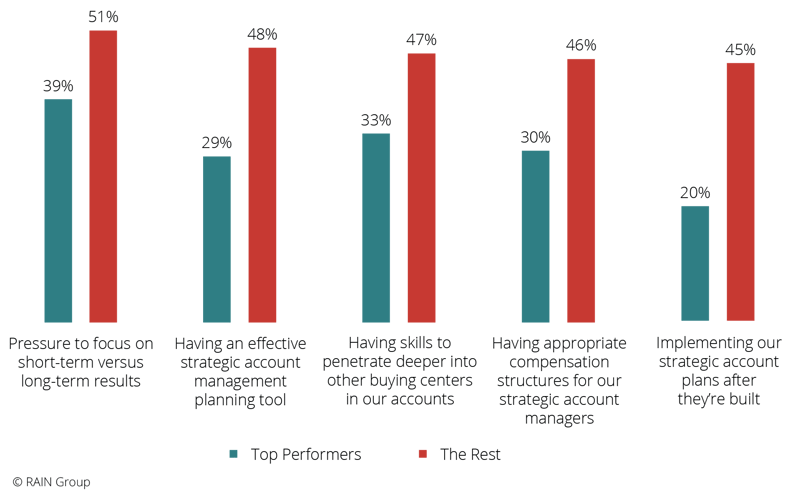
Source: Top Performance in Strategic Account Management Benchmark Report, RAIN Group Center for Sales Research
The Rest (bottom 87% of respondents) are more challenged by fundamental components:
- Having appropriate planning tools
- Following through with strategic account plans
Top 5 SAM Challenges That are Challenging or Very Challenging for Top Performers
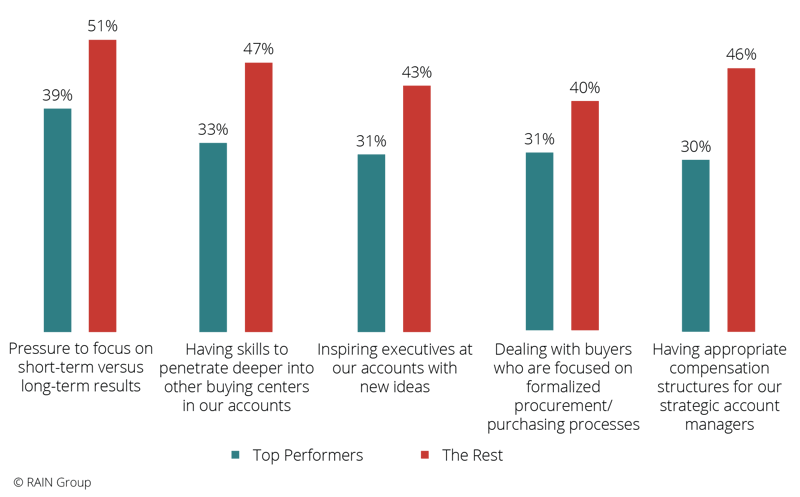
Source: Top Performance in Strategic Account Management Benchmark Report, RAIN Group Center for Sales Research
The two challenges that appear in the top 5 for Top Performers, but not The Rest, are "inspiring executives at our accounts with new ideas" and "dealing with buyers who are focused on formalized procurement/purchasing processes."
While some of the challenges overlap, Top Performers struggle less with fundamental challenges such as having an effective account planning tool and implementing strategy. Instead, they tackle more structural and enterprise issues like winning over top executives and working with procurement teams or similar.
Infographic: 10 Steps for Growing Your Key Accounts
Want to start building or reevaluating your organization’s account growth strategy? This infographic shares 10 of the most important tasks to get started—all key takeaways from this article.
Download the infographic (PDF).
4 Keys to Top Performance in Key Account Management
In this video, Jason Murray, Chief Sales Officer of RAIN Group, shares four keys to top performance, and how a Key/Strategic Account Management program can help teams learn a proven process to systematically grow accounts.
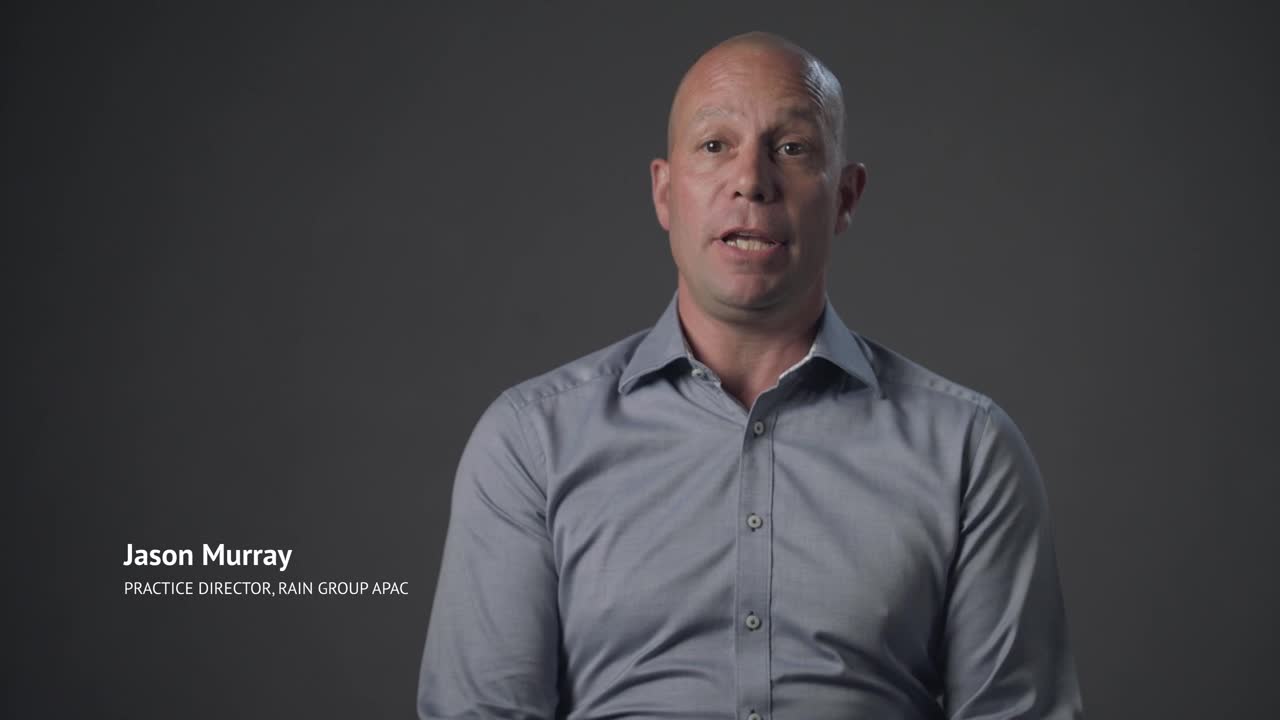
Take steps toward top performance by creating a universal key account definition, adopting a systematic, action-oriented process with specific outputs, and avoiding common pitfalls.






